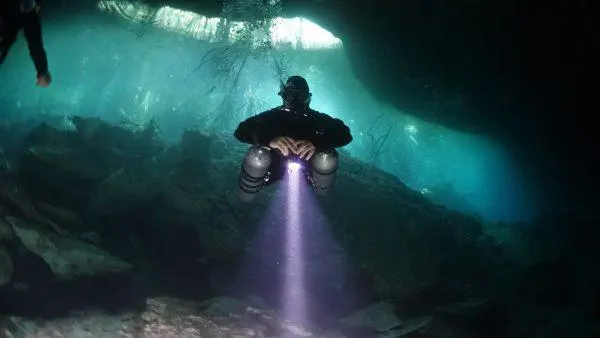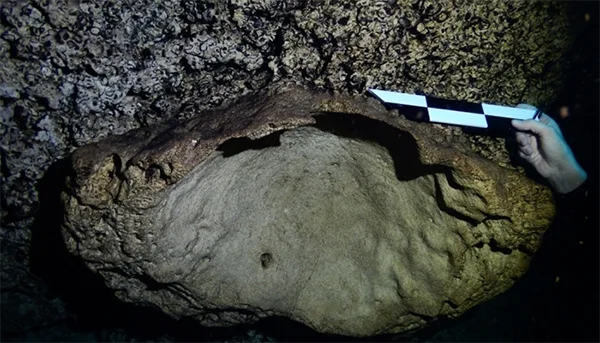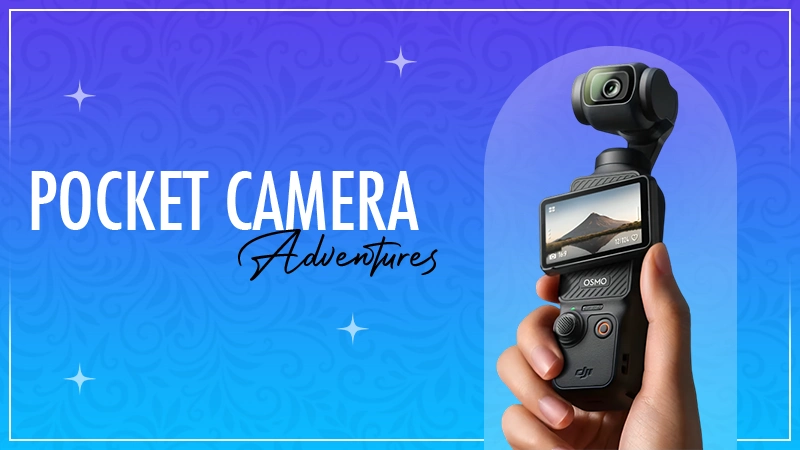
Key Takeaways
- Cenotes Are Unique Geological Wonders Formed by the collapse of limestone bedrock, exposing underground river systems.
- Some cenotes, like Angelita, contain thick layers of hydrogen sulfide, creating a fog-like effect.
- Fossils of extinct animals like mammoths and giant sloths have been found in cenotes.
- Archaeologists have discovered ancient artifacts, ceramics, and even gold within cenotes.
- These dives offer a unique blend of history, adventure, and natural beauty.

Imagine you are swimming through an underwater church, archaeological caves, and a deep, crystal-clear ocean where light filters like liquid glass. Sounds interesting, right? Today, we will talk about cenote diving, which makes scuba diving a thousand times more fascinating and gives surreal experiences to the doers. If you love unique diving spots, you might also enjoy Diving and Snorkeling at Mangrove Point at Nusa Lembongan, Bali.
Mexico’s Yucatán Peninsula is one of the largest cenote complexes in the world, with over 6000 cenotes, and many of those are open for diving, giving unique underwater experiences to the people. (Source: Wikipedia) These freshwater sinkholes are sacred to the Maya civilization but now are playgrounds for divers from all over the world.
Jacques Cousteau, who was a famous French naval officer, oceanographer, filmmaker, and author, once said, “The sea, once it casts its spell, holds one in its net of wonder forever,” and trust me, cenotes are no different. Well, I know you guys must be convinced, but let’s begin to know more of the reasons why cenote is an unforgettable experience.
1. Unique Geological Formations Like No Other
Cenotes are natural ponors that have crystal clear water that shows unique geographical features like speleothems and create magical landscapes. But the main question is, how are they formed? Well, these are formed by the collision of limestone bedrocks that discloses the labyrinthine below the river systems.
These underwater journeys are not just about diving underwater but are also about exploring historic caches that have been sculpted over millions of years. It has a unique ecosystem created for every attribute, which makes a comfortable environment for different species. Cavern cenotes, semi-open cenotes, and open cenotes are three of its main types.
2. The Halocline—A Mind-Bending Visual Phenomenon
Have you ever hallucinated? Well, that is what Haloclince feels like. It’s a liminal space where saltwater and freshwater meet, creating a blurry and wavy boundary because of its unstable diffraction of light. This illusion is exclusive and can be found in some cenotes only where the estuary is available.
The view will feel like you are watching the heatwaves underwater, which also makes it one of the spellbinding experiences you can have while diving. In some cenotes like Riviera Maya, the bathtub effect is caused when water hits the salty layer. Angelita and Calavera are also known for their halocline effect.
Did you know?
No Two Cenotes Are the Same. Each of them has different geological formations.
3. Descending Into Clouds of Hydrogen Sulfide
Some cenotes are made of hydrogen sulfide, and when the divers pass through these cloud-like layers, it creates a foggy effect that looks nothing less than a fictional film, creating an ethereal experience for viewers. These are around 100 feet down underwater and created by the decomposition of organic matter in the absence of oxygen.
This experience sounds very adventurous, but it can be dangerous at times, as hydrogen sulfide is a toxic gas and breathing it is also considered deadly. A well-known example of such cenotes is Angelita.
4. Fossils Trapped in Time

These sinkholes are not just an adventure but a journey to the ancient times. Some caves have the fossils of extinct animals like mammoths and giant sloths, while some have the preserved legacy of the Mayan culture. In fact, a variety of wooden tools like weapons, sculptures, idols, and jewelry have been found within these cenotes. (Wikipedia)
In 2007, some divers discovered a nearly complete, 12,000 to 13,000-year-old human skeleton and nicknamed it as “Naia” in the Hoyo Negro cenote (a submerged cave) near Tulum, Mexico, which is one of the oldest human remains found in the Americas. ( NBC news )
The oldest charcoal remains, of about 10,000 years back, were also found engulfed in a Yucatán Peninsula cenote, Mexico. There is an area named ring of cenotes which is a geographical formation made of a series of natural wells on the yucatan peninsular reflecting the topographic features of chicxulub crater. Dos ojos, Calavera, gran Cenote are some of the cenotes that are famous for their fossils.
5. A Portal to Mayan History and Artifacts
Cenotes were sacred by the ancient Maya as they believed it was not just a source of water but a way to the underworld (Xibalba). Archaeologists have discovered a plethora of artifacts, ceramics, and even gold in these submerged chambers, which were offered to the god during the ceremonies made by the Maya.
The 12,000-year-old human artifacts and remains are located in the depths of these cenotes, and the reason for all of these upholdings is stable water conditions in the deep ocean. The best example of a cenote used for ritual purposes is the Sacred Cenote at Chichen Itza.
Did you know?
The Mayans were chocolate lovers, so they also used chocolate for their religious ceremonies and as a form of currency.
Conclusion
After knowing all this, you will surely agree with me that Cenote diving is a combined experience of nature, science, and ancient mystery. In fact, more than 150,000 divers visit the cenotes of Mexico every year, which notably contributes to its local economy and the tourism industry.
As seen at the Jaguar Divers website, these awesome dives are a rare mix of thrill and amazement, offering both newbies and experienced divers a world-class experience.
So, if you are someone who is interested in geology, cultural history, or surreal visuals, this underwater world has some very exciting opportunities that you can’t find anywhere else on this planet. Go and try now!
What is so special about cenotes?
The cenotes are seen as the symbol of duality as they represent life and death in Maya culture.
Is diving in cenotes worth it?
Yes, it is an ecosystem that is prepared for over 1000s of years offering calm, clear water and ancient fossils.
What is the spiritual significance of the cenotes?
It was believed to be the way to the underworld, governed by 12 gods.
Why are cenotes so clear?
The water in it is rainwater that is filtered through the ground, removing impurities and creating pure water.
Were cenotes used for sacrifices?
Yes, it was a place for human sacrifices and other rituals.







